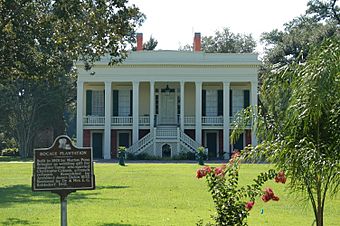Bocage Plantation facts for kids
Quick facts for kids |
|
|
Bocage Plantation
|
|

Plantation House
|
|
| Location | On River Road, about 100 yards (91 m) north of intersection with St. Elmo Street |
|---|---|
| Nearest city | Darrow, Louisiana |
| Area | 3.5 acres (1.4 ha) |
| Built | 1801, 1837 |
| Architect | Attributed to James H. Dakin |
| Architectural style | Greek Revival, French Creole |
| NRHP reference No. | 91000705 |
| Added to NRHP | June 20, 1991 |
Bocage Plantation is a beautiful old estate located in Darrow, Ascension Parish, Louisiana, about 25 miles southeast of Baton Rouge. The main house was built in 1837. It shows off a style called Greek Revival, but it also has some French Creole touches. This historic plantation was added to the National Register of Historic Places on June 20, 1991.
Contents
The Story of Bocage Plantation
How It Began
Bocage Plantation started in January 1801. This was five years after Étienne de Boré showed that growing sugarcane could make money in southern Louisiana. It was also two years before the Louisiana Purchase, when the United States bought a huge amount of land from France.
The plantation was a wedding gift. It came from Marius Pons Bringier, a wealthy planter from St. James Parish, Louisiana. He gave it to his 14-year-old daughter, Francoise "Fanny" Bringier. She was marrying Christophe Colomb, a 34-year-old man from Paris who enjoyed life and parties.
The Original House
The first house on the plantation was built in 1801. It was a "raised Creole house." This means it had a brick first floor supporting a wooden frame above. Sadly, this house was destroyed by fire sometime before 1837.
For a while, people thought the current house was built on the same spot as the old one. But during a restoration project in 2008, something interesting was found. The bases of four chimneys were discovered buried about 40 feet behind the current house. These bases were surrounded by charred remains and old glass from the 1800s. This showed that the first house was in a different spot.
The Main House Today
The current house was built in 1837. Many people believe James H. Dakin designed it. He was an architect who came to Louisiana in 1835 and worked for the Bringier family. He was very good at Greek Revival architecture.
The front of the house has some special features. It has a huge entablature (the part above the columns). This part has a pediment design and a fancy cornice (a decorative molding). This whole section is held up by large, square columns that go all the way up the front, creating a double gallery (like two stacked porches).
The front staircase you see today wasn't always there. It was added back during the 2008 restoration. This was done based on the oldest known picture of Bocage, a watercolor painting from the early 1900s. The upper gallery (top porch) was even used to film a scene in the movie 12 Years a Slave.
The upper gallery opens into a large double parlor (living room) on the main floor. In the Creole style, rooms often open into each other without hallways. At the back, there's a cabinet-loggia (a covered outdoor space). Huge twelve-foot-tall sliding doors can separate the upper parlors. The roof of the house used to collect rainwater. This fresh water was sent through pipes to large tanks on each side of the house.
Restoring Bocage
Over the years, the house was not well cared for. But in 1941, Drs. E. G. Kohlsdorf and Anita Crozat (Mrs. Kohlsdorf) restored it. In 2007, some of the house's old furniture was sold at an auction.
Then, in 2008, the house was restored again by its new owner, Dr. Marion Rundell. After this, Bocage Plantation became a B&B (a place where people can stay overnight). It also started offering public tours, so visitors could explore its history.
Where is Bocage?
Bocage Plantation is located on Louisiana Highway 942, which is part of the River Road. It's in Darrow, Ascension Parish. The plantation is on the east side of the Mississippi River. However, because of a bend in the river, it actually sits north and west of the river itself. It's across the river from Donaldsonville and about 25 miles southeast of Baton Rouge.


